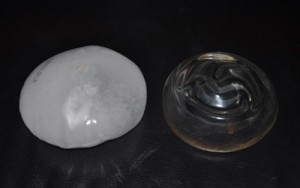In this very cold and arctic winter, it is no surprise that I have heard more than one breast augmentation patient ask if their implants could freeze. The answer, of course, is no since they are placed within one’s body under the muscle and the temperature around them never drops below 98 degrees F. The exception, however, is if the person froze first.
But for the purpose of scientific discussion, can breast implants freeze? (when out of the body) That depends on whether one is talking about saline or silicone breast implants. A saline implant refers to one filled with essentially salt water. The addition of salt in the water drops its freezing temperature but not appreciably. Using salt water as a corollary, it has a freezing temperature lower than pure water at roughly 29 degrees F or -2 degrees C. As the saline fluid freezes, its volume expands but the stretch of the silastic shell that contains it does not result in its disruption. This can be quickly confirmed by placing a saline breast implant in the freezer.

Dr. Barry Eppley
Indianapolis, Indiana


